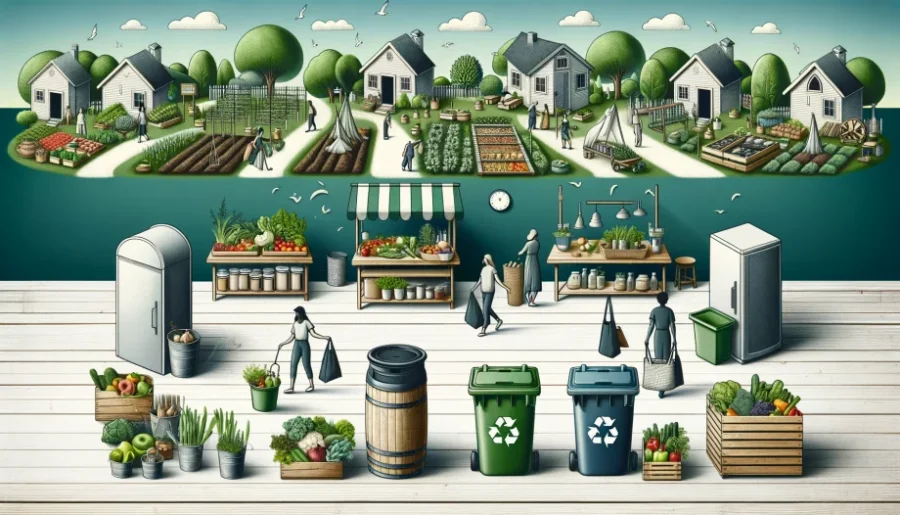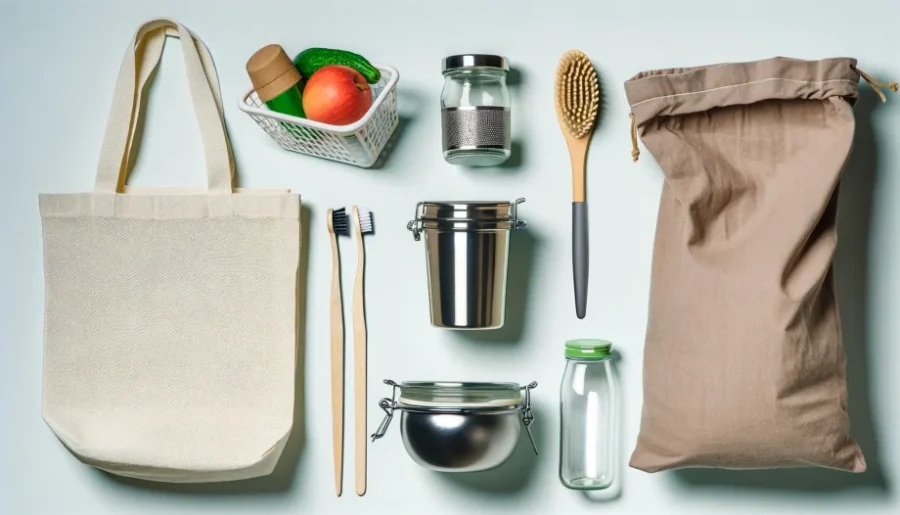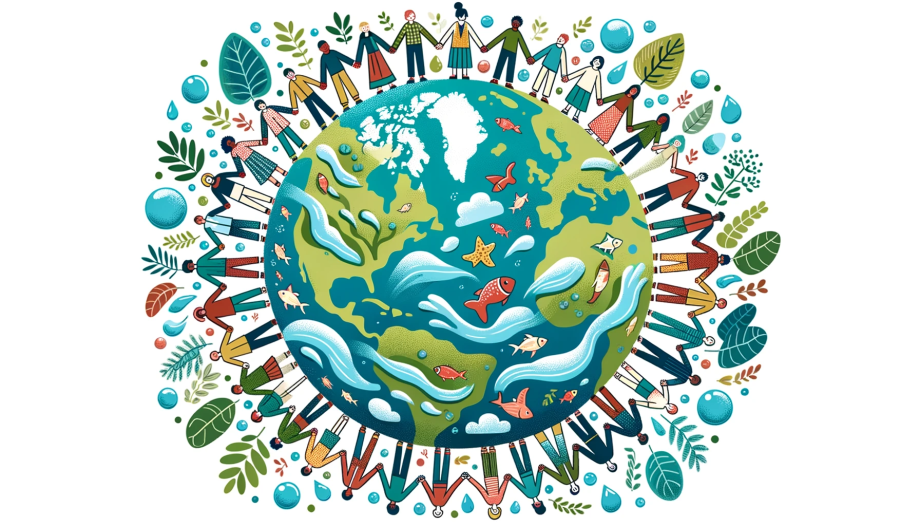
Discover how to start implementing zero-waste in daily life. Learn practical tips and strategies to reduce waste, live sustainably, and make a positive impact on the planet.
Implementing Zero-Waste Key Takeaways:
- Implementing Zero-Waste in Daily Life:
- It involves adopting sustainable practices such as using reusable items,
- Composting organic waste, and minimizing single-use plastics.
- It’s a commitment to reducing our environmental impact and living more consciously for a greener future.
Implementing zero-waste in daily life is a journey towards sustainability that anyone can embark on.
It’s about making conscious choices to reduce waste, reuse resources, and recycle effectively.
From simple swaps to mindful consumption, let’s explore how we can embrace zero-waste practices in our everyday lives and contribute to a healthier planet.
Implementing Zero-Waste in Daily Life
Zero-waste living is a journey toward reducing our environmental impact.
It’s about making conscious choices to minimize waste in our daily lives.
By understanding the concept of zero waste and its importance, we can take steps to protect our planet.
Let’s explore how zero-waste practices can be integrated into everyday living for a healthier, more sustainable future.
Understanding Zero Waste
Zero waste is a philosophy that encourages the redesign of resource life cycles so that all products are reused.
The goal is for no trash to be sent to landfills, incinerators, or the ocean. It’s about finding ways to reduce our waste footprint and make the most of our resources.
Zero waste, or waste minimization, is a set of principles focused on waste prevention that encourages redesigning resource life cycles so that all products are repurposed (i.e. “up-cycled”) and/or reused. The goal of the movement is to avoid sending trash to landfills, incinerators, oceans, or any other part of the environment. Wikipedia
The Importance of Zero Waste
Adopting a zero-waste lifestyle is crucial for environmental sustainability.
It helps reduce pollution, conserve resources, and mitigate climate change.
By embracing zero waste, we can create a cleaner, greener world for future generations.
1. What is Zero Waste?

Zero waste is a way of living that aims to reduce the amount of trash we create. It’s about choosing reusable items, recycling, and composting to keep things out of landfills and oceans.
The goal is to make sure everything we use can be reused or turned into something new. This helps keep our planet clean and saves valuable resources.
Principles of a Zero-Waste Lifestyle
There are a few key ideas for zero waste:
- Refuse: Say no to things you don’t need, like single-use plastics.
- Reduce: Use less and choose items that last longer.
- Reuse: Find new ways to use things instead of throwing them away.
- Recycle: Turn used items into new ones.
- Rot: Compost food scraps and other organic materials.
Impact on Environmental Sustainability
Zero waste is great for the environment. It cuts down on pollution, saves energy, and reduces the need for new materials.
By living a zero-waste life, we can help keep our planet healthy and make sure there are enough resources for everyone in the future.
Read more and find out why zero-waste matters.
2. Zero Waste Tips for Beginners
Starting a zero-waste journey can be simple and rewarding. Here are some easy steps to help you begin:
Begin with Small Changes
- Reusable Bags: Bring your own bags when shopping to reduce plastic waste.
- Water Bottle: Use a reusable water bottle instead of buying plastic ones.
- Say No to Straws: Skip plastic straws or use a reusable alternative.
Incorporate Zero-Waste Practices into Daily Routine
- Compost: Start composting food scraps to reduce landfill waste.
- Buy in Bulk: Purchase food and other items in bulk to avoid packaging.
- DIY Cleaning Products: Make your own cleaning solutions with natural ingredients.
Table 1: Zero Waste Tips for Beginners
| Tip | Description |
|---|---|
| Use Reusable Bags | Bring your own bags for shopping to reduce plastic waste. |
| Ditch Disposable Water Bottles | Use a reusable water bottle instead of buying plastic ones. |
| Compost Food Scraps | Start composting to turn your food waste into nutrient-rich soil. |
| Buy in Bulk | Purchase food and other products in bulk to reduce packaging waste. |
| Avoid Single-Use Items | Replace disposable items like straws, cutlery, and plates with reusable alternatives. |
By taking these small steps, you can make a big impact on reducing waste in your daily life.
3. How To Reduce Waste in Everyday Life

Reducing waste in our daily lives is essential for a sustainable future. Here are some strategies to minimize waste in various aspects of everyday living:
Minimizing Waste in the Kitchen
- Meal Planning: Plan your meals to avoid buying more food than you need.
- Composting: Compost food scraps to reduce landfill waste.
- Reusable Containers: Use containers that can be washed and reused instead of disposable packaging.
Reducing Waste in Personal Care
- Eco-Friendly Products: Choose products with minimal packaging or refillable options.
- DIY Beauty: Make your own beauty products using natural ingredients.
- Bar Soaps: Opt for bar soaps instead of liquid soaps in plastic bottles.
Minimizing Waste at Work
- Digital Documents: Use digital files instead of printing on paper.
- Reusable Office Supplies: Use items like refillable pens and rechargeable batteries.
- Bring Your Own: Bring your own lunch and coffee cup to reduce disposable packaging.
The Importance of Reducing, Reusing, and Recycling
Reducing, reusing, and recycling are essential components of waste management. Each of these actions plays a crucial role in minimizing our environmental impact.
Reduce: The first step in waste management is to reduce the amount of waste we produce.
This can be achieved by making conscious choices about our consumption habits, such as opting for products with minimal packaging, buying only what we need, and choosing durable items that last longer.
Reuse: Reusing items extends their lifespan and reduces the need for new products.
Simple actions like using refillable water bottles, repurposing containers, and donating items we no longer need can significantly cut down on waste.
Recycle: Recycling transforms used materials into new products. It helps conserve natural resources, saves energy, and reduces greenhouse gas emissions.
Proper recycling involves sorting materials correctly and ensuring they are clean and dry.
By embracing these principles, we can collectively reduce the amount of waste that ends up in landfills and oceans, contributing to a healthier and more sustainable environment.
4. Zero Waste Lifestyle
The zero-waste lifestyle is about living in a way that reduces our impact on the environment. It’s about making choices that prevent waste from being created in the first place.
Exploring the Zero-Waste Lifestyle
Living-zero waste means:
- Refusing: Say no to things you don’t need, like single-use plastics.
- Reducing: Use less and choose items that last longer.
- Reusing: Find new ways to use things instead of throwing them away.
- Recycling: Turn used items into new ones.
- Rotting: Compost food scraps and other organic materials.
Benefits of a Zero-Waste Lifestyle
Going zero waste can:
- Save Money: By buying less and using things longer, you can save money.
- Reduce Pollution: Making less trash means less pollution in the air, land, and water.
- Conserve Resources: Using less stuff means fewer resources are needed to make new things.
Case Studies of Zero-Waste Living
- Bea Johnson’s Family: Bea Johnson and her family live a zero-waste life in California. They produce only a jar of trash each year by following the 5 Rs of zero waste.
- Lauren Singer: Lauren lives in New York and has been living zero waste for years. She fits her yearly trash into a single jar and shares tips on her blog, Trash is for Tossers.
By following these principles and learning from others, we can work towards a zero-waste lifestyle that benefits both us and the planet.
Read more about expanding zero-waste principles and practices.
5. Zero Waste Importance
Zero waste is vital for the well-being of our planet and future generations. It’s a sustainable approach that aims to eliminate waste and promote the responsible use of resources.
Why Zero Waste Matters
- Conserves Resources: Zero waste practices help conserve natural resources by reducing the demand for new materials.
- Reduces Pollution: By minimizing waste, we can reduce pollution in the air, water, and soil, leading to a cleaner environment.
- Protects Ecosystems: Less waste means less harm to ecosystems and wildlife, preserving biodiversity.
- Addresses Climate Change: Zero waste reduces greenhouse gas emissions from waste management processes like landfilling and incineration.
The Role of Zero Waste in Combating Climate Change and Pollution
Zero waste plays a crucial role in fighting climate change and pollution:
- Reducing Carbon Footprint: By minimizing waste, we can lower the carbon footprint associated with the production, transportation, and disposal of goods.
- Promoting Circular Economy: Zero waste encourages a circular economy, where products are designed to be reused, repaired, and recycled, reducing the need for virgin materials.
- Encouraging Sustainable Practices: Adopting zero waste habits can inspire individuals, communities, and businesses to adopt more sustainable practices, leading to a positive ripple effect.
Understanding the importance of zero waste and its role in environmental protection is essential for making informed choices that benefit both people and the planet.
6. Is a Zero Waste Lifestyle Possible?
Adopting a zero-waste lifestyle can be challenging, but it is possible with dedication and effort. Let’s explore the feasibility of achieving zero waste and some inspiring success stories.
Challenges of a Zero-Waste Lifestyle
- Availability of Alternatives: Finding zero-waste alternatives for everyday products can be difficult, especially in areas with limited access to bulk stores or eco-friendly products.
- Convenience: The convenience of single-use items can be hard to give up, requiring a mindset shift toward sustainability.
- Cost: Initially, some zero-waste products may have a higher upfront cost, although they can save money in the long run.
Feasibility of Achieving Zero Waste
- Gradual Changes: Start with small, manageable changes and gradually incorporate more zero-waste practices into your life.
- Community Support: Joining a community of like-minded individuals can provide support, resources, and motivation.
- Education and Awareness: Learning about the impacts of waste and the benefits of zero waste can inspire action and commitment.
Success Stories and Examples
- Bea Johnson: Bea Johnson, author of Zero Waste Home, has been living a zero-waste lifestyle with her family since 2008, producing only a jar of trash per year.
- Kathryn Kellogg: Kathryn Kellogg, the author of 101 Ways to Go Zero Waste, shares practical tips and advice on her blog, Going Zero Waste, to help others reduce their waste.
- Lauren Singer: Lauren Singer, founder of Package Free Shop and the blog Trash is for Tossers, has been living zero waste for several years, fitting her annual trash into a single jar.
While a completely zero-waste lifestyle may not be achievable for everyone, every effort toward reducing waste makes a difference.
By embracing zero-waste principles and learning from those who have successfully reduced their waste, we can work toward a more sustainable future.
7. 10 Ways to Reduce Waste at Home
Reducing waste at home is easier than you might think. Here are ten practical tips to help you get started:
1. Use Reusable Bags
- Say goodbye to plastic bags. Bring your own reusable bags for shopping.
2. Ditch Disposable Water Bottles
- Invest in a reusable water bottle and refill it instead of buying plastic ones.
3. Compost Food Scraps
- Start composting to turn your food waste into nutrient-rich soil.
4. Buy in Bulk
- Purchase food and other products in bulk to reduce packaging waste.
5. Avoid Single-Use Items
- Replace disposable items like straws, cutlery, and plates with reusable alternatives.
6. Recycle Properly
- Make sure to recycle according to your local guidelines.
7. Repair Instead of Replace
- Fix broken items when possible instead of throwing them away.
8. Donate Unused Items
- Give away clothes, toys, and other items you no longer need.
9. Use Cloth Instead of Paper
- Opt for cloth napkins and towels instead of paper ones.
10. Plan Your Meals
- Plan your meals to avoid food waste and only buy what you need.
Table 2: 10 Ways to Reduce Waste at Home
| Way to Reduce Waste | Description |
|---|---|
| Use Reusable Bags | Bring your own bags for shopping to reduce plastic waste. |
| Ditch Disposable Water Bottles | Use a reusable water bottle instead of buying plastic ones. |
| Compost Food Scraps | Start composting to turn your food waste into nutrient-rich soil. |
| Buy in Bulk | Purchase food and other products in bulk to reduce packaging waste. |
| Avoid Single-Use Items | Replace disposable items like straws, cutlery, and plates with reusable alternatives. |
| Recycle Properly | Make sure to recycle according to your local guidelines. |
| Repair Instead of Replace | Fix broken items when possible instead of throwing them away. |
| Donate Unused Items | Give away clothes, toys, and other items you no longer need. |
| Use Cloth Instead of Paper | Opt for cloth napkins and towels instead of paper ones. |
| Plan Your Meals | Plan your meals to avoid food waste and only buy what you need. |
Implementing These Tips Effectively
Start with one or two changes and gradually add more as you get comfortable. Share your journey with family and friends to encourage them to reduce waste too.
Remember, every small action counts towards a more sustainable home.
For more tips on reducing waste at home, check out resources like the EPA’s Reducing Wasted Food at Home and Zero Waste Home.
8. 10 Ways to Adopt a Zero Waste Lifestyle
Adopting a zero-waste lifestyle is a journey that requires commitment and continuous improvement. Here’s a comprehensive guide to help you embrace zero waste in all aspects of life:
1. Refuse What You Don’t Need
- Say no to unnecessary items like single-use plastics and junk mail.
2. Reduce Your Consumption
- Buy only what you need and prioritize quality over quantity.
3. Reuse and Repurpose
- Find new uses for items before throwing them away. Shop second-hand when possible.
4. Recycle Properly
- Follow local recycling guidelines and recycle as much as you can.
5. Compost Organic Waste
- Start composting at home to turn food scraps and yard waste into valuable compost.
6. Choose Sustainable Products
- Opt for products made from sustainable materials and with minimal packaging.
7. Support Zero Waste Businesses
- Patronize businesses that prioritize sustainability and zero-waste practices.
8. Educate Yourself and Others
- Learn about zero waste and share your knowledge with friends and family.
9. Get Involved in Your Community
- Participate in community clean-up events and advocate for zero-waste policies.
10. Continuously Improve
- Keep looking for ways to reduce your waste and make more sustainable choices.
By following these steps and staying committed to your zero-waste journey, you can make a significant impact on reducing your environmental footprint.
Remember, every small action counts towards a cleaner and more sustainable planet.
9. Zero Waste Project Ideas
Implementing zero waste at home and in the community can be creative and impactful. Here are some project ideas to get you started:
For Home:
- DIY Zero Waste Kitchen Sponge: Make your own reusable kitchen sponges from old fabrics to reduce waste from disposable sponges.
- DIY Zero-Waste Produce Bags: Sew reusable produce bags to avoid using plastic bags at the grocery store.
- DIY Homemade Dryer Sheets: Create reusable dryer sheets to replace disposable ones, reducing waste and chemicals in your laundry.
- Upcycled Flannel Hankies: Turn old flannel shirts into reusable handkerchiefs, reducing the need for disposable tissues.
- DIY Homemade Laundry Detergent: Make your own laundry detergent to reduce packaging waste and control the ingredients used.
- Easy 5-Minute Wash Cloth Soap Holder: Sew a simple soap holder to keep your soap bars organized and reduce the need for liquid soaps in plastic bottles.
- DIY Reusable Bowl Covers: Replace plastic wrap with homemade reusable bowl covers for storing leftovers.
- DIY Reusable Snack Bag: Create snack pouches from fabric to carry small bites without disposable packaging.
- DIY Reusable Hand Warmers: Repurpose old flannel shirts into hand warmers that can be reheated and reused.
- DIY Foldable Reusable Grocery Bags: Sew durable and foldable grocery bags to replace single-use plastic bags.
For Community:
- Lead by Example: Start by adopting zero waste practices yourself and inspire others by sharing your journey.
- Join or Start a Community Garden: Grow your own food and encourage others to do the same, reducing food miles and packaging waste.
- Educate Local Businesses: Talk to local stores and restaurants about reducing plastic use and offering sustainable alternatives.
- Organize Zero Waste Workshops: Host workshops to teach others about zero-waste living and how to make eco-friendly products.
- Organize Neighborhood Clean-ups: Gather volunteers to clean up local areas, reducing litter and raising awareness about waste.
- Host Zero-Waste Meetups: Create a community of like-minded individuals to share ideas and support each other’s zero-waste efforts.
- Speak at Town Hall Meetings: Use public forums to advocate for zero waste initiatives and policies in your community.
- Start a Petition: Rally support for specific zero waste goals or changes in your area.
- Utilize Social Media: Share tips, success stories, and resources online to reach a wider audience.
- Host a Zero-Waste Film Night: Screen documentaries and films that highlight environmental issues and solutions.
By implementing these projects, you can significantly promote zero-waste living and inspire others to join the movement.
10. Zero Waste Management
Zero waste management is a sustainable approach to handling waste. It aims to reduce, reuse, and recycle materials to prevent them from ending up in landfills or incinerators.
Understanding Zero Waste Management
Zero waste management focuses on:
- Preventing Waste: The first step is to avoid creating waste. This can be done by choosing products with minimal packaging and using reusable items.
- Reusing Materials: Before recycling or disposing of an item, consider if it can be reused or repurposed.
- Recycling: Properly sorting and recycling materials helps to reduce the amount of waste sent to landfills.
Best Practices for Managing Waste Sustainably
- Conduct a Waste Audit: Assess the types and amounts of waste you produce to identify areas for improvement.
- Set Zero Waste Goals: Establish clear targets for waste reduction and track your progress.
- Educate and Engage: Inform your household, community, or workplace about zero waste practices and encourage participation.
- Composting: Start composting organic waste to create nutrient-rich soil for gardening.
- Support Circular Economy: Choose products that are designed to be repaired, reused, or recycled.
By implementing zero waste management practices, we can significantly reduce our environmental impact and contribute to a more sustainable future.
For more information on zero waste management, check out resources from the Zero Waste International Alliance (ZWIA)
FAQs: Zero Waste Questions Answered
Embarking on a zero-waste journey can raise many questions. In this section, we address some common queries to help you understand and embrace zero waste.
Q: How do you implement a zero-waste system?
A: Implementing a zero-waste system involves minimizing waste by refusing, reducing, reusing, recycling, and composting.
Start by making small changes, such as using reusable bags and containers, and gradually incorporate more zero-waste practices into your daily routine.
Q: Why do we need to live a zero-waste life?
A: Living a zero-waste life is crucial for reducing pollution, conserving resources, and combating climate change.
It helps protect ecosystems and promotes a sustainable future for our planet and future generations.
Q: What are the activities of zero-waste?
A: Zero-waste activities include using reusable items, buying in bulk, composting organic waste, recycling properly, repairing items instead of discarding them, and supporting products and businesses that prioritize sustainability.
Q: How do you think we will be able to achieve zero waste?
A: Achieving zero waste will require a collective effort from individuals, communities, businesses, and governments.
Education, policy changes, and innovative solutions for waste management are key to transitioning toward a zero-waste society.
Q: How can you contribute to promoting a zero-waste future?
A: You can contribute by adopting zero-waste practices in your own life, educating others about the importance of waste reduction, supporting sustainable businesses, and advocating for policies that promote zero-waste.
Q: What are 5 habits you can adopt to reduce waste and promote recycling?
A: Five habits include using
- reusable bags
- bottles, and containers
- avoiding single-use plastics
- composting food scraps, recycling correctly
- and buying products made from recycled materials.
Q: What are 10 ways to reduce waste?
A: Ten ways to reduce waste include:
- refusing unnecessary items,
- using reusable alternatives,
- repairing instead of replacing,
- composting,
- recycling,
- buying in bulk,
- choosing products with minimal packaging,
- donating unused items,
- supporting eco-friendly businesses,
- and reducing food waste.
Q: How can we reduce food waste in our daily life?
A: To reduce food waste, plan your meals, shop with a list, store food properly, use leftovers creatively, and compost any unavoidable waste.
Q: What is an example of how you can reduce, reuse, and recycle?
A: An example is using a reusable water bottle (reduce), repurposing glass jars for storage (reuse), and recycling paper and cardboard products (recycle).
By addressing these questions and adopting zero waste practices, we can make a positive impact on the environment and work towards a more sustainable future.
Conclusion: Committing to Zero Waste
As we wrap up this guide on implementing zero waste in daily life, it’s clear that every individual effort counts. By committing to a zero-waste lifestyle, we can significantly reduce our environmental impact and contribute to a healthier planet.
Read more: Mastering Zero-Waste Living: 7 Easy Tips and Tricks
Taking Action for a Sustainable Future
- Start Small: Begin with small changes that are manageable for you. Every step towards zero waste is a step in the right direction.
- Stay Informed: Keep learning about zero waste practices and how you can improve.
- Spread the Word: Share your zero-waste journey with others to inspire and encourage collective action.
The Power of Collective Impact
When we all work together, our individual actions can lead to significant environmental benefits.
Reducing waste, conserving resources, and minimizing pollution are crucial for maintaining a sustainable planet.
By embracing zero waste, we can create a cleaner, greener, and more sustainable future for all.
Resources: Enhancing Your Zero-Waste Journey
To further support your zero-waste efforts, here are some authoritative resources that provide valuable information, tips, and guidance:
- U.S. Environmental Protection Agency (EPA) – Net Zero Resources: The EPA offers a range of resources on conserving water, reducing energy use, and eliminating solid waste to improve the environment and promote sustainability. Explore EPA’s Net Zero Resources.
- World Resources Institute (WRI) – Zero Waste: WRI provides insights and research on waste reduction, the transition to a circular economy, and tackling the impact of fast fashion and food loss. Learn more about Zero Waste at WRI.
- U.S. Environmental Protection Agency (EPA) – How Communities Have Defined Zero Waste: This resource offers various definitions and approaches to zero waste adopted by communities and organizations, highlighting the importance of a comprehensive waste management strategy. Discover How Communities Have Defined Zero Waste.
By exploring these resources, you can deepen your understanding of zero-waste practices and discover new ways to make your lifestyle and community more sustainable.
Read more: Upcycling Projects for Beginners







